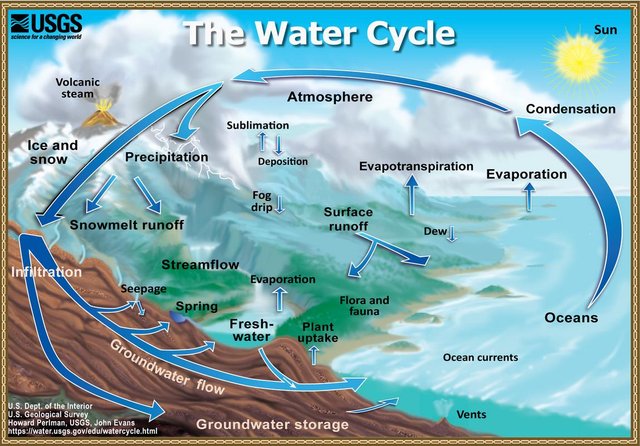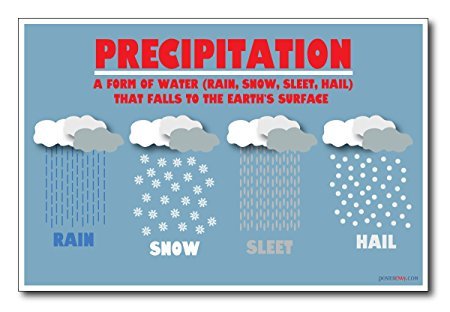PRECIPITATION - What you knew and What you didnot Know

What do you see above in the image?. It looks like its going to be a rainy day, why not put on your rain coat or rather place an umbrella over your head.
Ever wondered what prompts the fall of water droplets from the clouds to the earth's biosphere. Majority exclaims _ its due to the saturation of the atmosphere(clouds)when its capacity to contain more water vapor is exceeded. A few suggests it happens because its a stage in water cycle.
But however, science as a whole claims that these droplets of water fall by means of precipitation(A stage in water cycle).
What's your own perception?
So what is precipitation?

Precipitation is the product of the condensation of the atmospheric water vapor that's fall under gravity. So without condensation, precipitation would not occur; It is also linked as a stage in Water cycle.
Water cycle explains the overall view of the movement of water from its solid, liquid and gaseous state. Water exist in various form like any matter do in its physical state.
It is best explained from the diagram below:

In water cycle, water in its solid state(Ice) is heated by the sun's rays or ions through radiation forming a liquid. And this liquid(in the form of rivers, oceans) is continuously heated resulting to water vapor(gaseous state).
The water vapour suspends in the atmosphere to form clouds. The continuous gathering of water vapor brings about a condensation process.
When this water vapor condenses in the air, they form a [saturated solution](A saturated solution of a solute at a particular temperature is one which contains as much solute ash it can dissolve at that temperature in the presence of undissolved solute particles).
When the saturation limit of the atmosphere is exceeded, the water vapor precipitates and falls down to the earth in the form of tiny droplets.
Mechanism of precipitation
Precipitation as a phenomenon in water cycle causes the release of water droplets from the atmosphere. These water droplets released to the earth are in various physical form or state. For example, Rain falls is one of those phenomenon in precipitation. It begins as condensed heavy water molecules(ice crust) and then melts further as it falls down to the earth surface.
These variation of Precipitation are in various collective names. And these collectively names are:
- Dew
- Frost
- Sleet
- Hail
- Gravel
- Snow
- Rain
Dew: are precipitates(water droplets) that appear on thin exposed objects seen in the morning or evening due to condensation. As the exposed surface cools by radiation, atmospheric moisture condenses at a rate greater than
that at which it could evaporate, resulting to the formation of water droplet.Frost: it is the deposit of ice in humid air mostly at cold conditions usually at nights. In hot area, it appears in the form of fragile whit crystals or frozen dew drops near the ground but in cold areas or climates it occurs in greater variety forms.
Sleet: It is a low distinct of precipitation that are rarely seen regionally(In various places). It is also a precipitate that forms ice pellet from the freezing of rain as it falls. In other words, It is snow and rain mixed together.
Hails: They are distinct solid ice pellets(precipitate) like sleets but rather different in mass. Hails consists of balls or irregular massive size of ice, each of which is called a hail stone. Hail stone forms during in tensed cold surface temperature, Whereas Sleets are produced in normal cold weathers.
Snow: It is the precipitation in the form of flakes crystalline water ice, that are mostly frozen crystalline water throughout its lifetime starting when it precipitates from clouds and gathers at the surface of the Earth.
Rain: is liquid water in the form of droplets that have condensed from atmospheric water vapor and then becomes heavy enough to fall under gravity. It is a major component of the water cycle and is responsible for depositing most of the fresh water on the Earth hydrosphere. It provides suitable conditions for many types of ecosystems, as well as water for hydroelectric power plants and crop irrigation.
The Forms of Precipitation explains how water droplets are viewed and seen in its physical state in a Temperate and cooled zones. Regardless of its precipitated form, Water droplets exhibits a different structure in the form of Fog or mist by Dispersion.
Dispersion of water molecules in air occurs when the super saturation of this droplets begins. During the Super Saturation caused by an external constraint(Heat), tiny droplets of water do-not fall to the surface of the earth but rather suspends in the atmosphere hereby causing a change in the relative humidity of air.
The forms of suspension in water cycle are:
- Mist
- Fog
Mist: It is a phenomenon caused by small droplets of water suspended in air. Physically, it is an example of a dispersion. It is most commonly seen where warm, moist air meets sudden cooling, such as in exhaled air in the winter, or when throwing water onto the hot stove of a sauna.
Fog: It consists of visible cloud water droplets or ice crystals suspended in the air at or near the Earth's surface. It may also be a type of low-lying cloud that are heavily influenced by nearby bodies of water, topography, and wind conditions.
That all there is to know about the formation of Rain and other forms of Precipitate in the atmosphere.
Reference:

@originalworks
The @OriginalWorks bot has determined this post by @obilovejoel to be original material and upvoted it!
To call @OriginalWorks, simply reply to any post with @originalworks or !originalworks in your message!